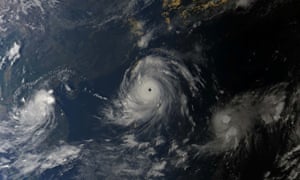Shutdowns and evacuations ordered, electricity cut and trail of damage reported from ‘world’s strongest typhoon this year’
 Satellite image of the Philippine island of Itbayat in the eye of typhoon Meranti. Photograph: CIMSS
Satellite image of the Philippine island of Itbayat in the eye of typhoon Meranti. Photograph: CIMSSNicola Smith in Taipei and agencies
Wednesday 14 September 2016 07.50 BSTLast modified on Wednesday 14 September 201611.21 BST
Tens of thousands of homes lost power across Taiwan as the island was hit by super-typhoon Meranti – a storm rated the strongest in the world so far this year – forcing schools and businesses to close and leading to flight cancellations.
Taiwan’s Central Weather Bureau warned that the category 5 storm would threaten southern and eastern cities, including Kaohsiung and Hualien, with strong winds, torrential rain and flooding.
Meranti, which grew in strength as it neared Taiwan, was carrying maximum winds of 134mph (216km/h), meteorologists said. Fallen power cables and trees were among some of the early damage reported on Wednesday.
“This typhoon is the world’s strongest so far this year,” said weather bureau spokeswoman Hsieh Pei-yun. “Its impact on Taiwan will peak all day today.”

FacebookTwitterPinterest Composite image of Category 5 super-typhoon Meranti. Photograph: 2016 Eumetsat
Companies and schools in Kaohsiung and other cities were closed and almost 1,500 residents were evacuated, the Central Emergency Operation Centre said.
Nearly 200,000 households were without electricity, according to Taiwan Power. Most domestic flights were cancelled, including all of those from Kaohsiung airport, where international flights were also severely affected.
Taiwan was expected to feel the full force of the typhoon on Wednesday and into Thursday before the storm reached China, meteorologists said.
Meranti was expected to make landfall in the southern Chinese provinces of Guangdong and Fujian on Thursday, where authorities were already cancelling train services and preparing to evacuate people, state media said.
In eastern Guangdong province, authorities ordered trawlers to return to harbour and fishermen to shelter on land from Meranti, which the official China News Service said could be the strongest typhoon to hit that part of China since 1969.
Typhoons are generated at this time of year, picking up strength as they cross the warm waters of the Pacific before bringing strong winds and violent rainstorms when they hit land.
Meranti comes just over two months after the deadly typhoon Nepartak cut power, grounded flights and forced thousands to flee their homes across central and southern areas of Taiwan.
In 2009, typhoon Morakot cut a swath of destruction through southern Taiwan, killing about 700 people and causing up to £2.3bn ($3bn) of damage.
Earlier, Meranti crossed the Philippines where there were fears for the safety of 3,000 inhabitants of the tiny island of Itbayat after satellite images showed it directly in the eye of the megastorm.
A weatherman at the Pagasa meteorological station in Manila, who gave his name as Rene, said that communications had not been established with Itbayat and that the local government was desperately trying to reach inhabitants.
“Maybe we can fix communications by tomorrow,” he said, as strong gusts of wind were still being recorded in the area and night was falling. Residents, already familiar with strong typhoons, would hopefully have been protected by the traditional stone houses with strong, thick walls, Rene added. “We pray there will be no casualties,” he said.
The weatherman added that it was unusual for the eye of a storm to be bigger than the size of an entire island.
